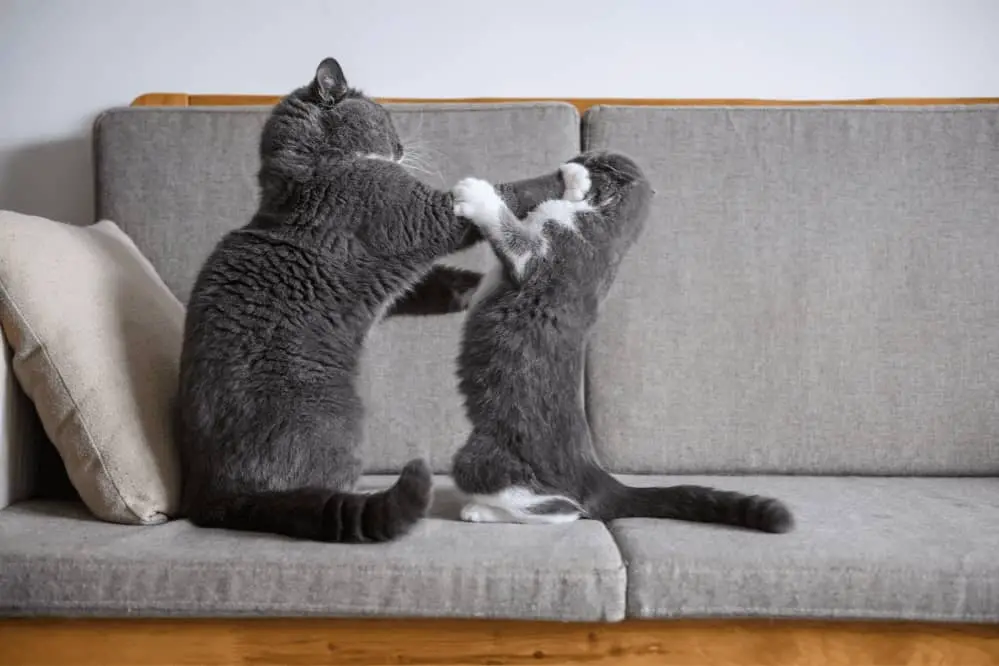Although almost all cats are swift and hard-headed, they sometimes exhibit some feline behavior that can easily be classified as bullying, for example, a cat attacking another cat without provocation. A bully cat can make life difficult for other cats in several ways which is why it’s important to recognize the signs so you can take action to stop it.
Why does my cat attack my other cat?
The first step towards stopping your cat from bullying your other cat is to understand the drive behind the behavior. Here are some common reasons for feline bullying:
Redirect aggression
Cats can get stressed from a variety of reasons which can trigger their reactive behavior that may include bullying. One of the chief reasons why cats get stressed out is due to changes in their surroundings. This change could either be environmental (e.g., moving/rearranging furniture or litter box stations) or social (e.g., addition or departure of another cat). When a cat is unable to get rid of the stress, he may resort to taking it out on another cat.
Establish dominance
Like humans, cats also strive for social dominance by challenging other felines. The aim is to elevate their status in the eyes of other cats and make them submissive. The behavior typically begins at 2-4 years when cats reach social maturity. They intimidate other cats in several ways which include: stares, body position, hisses, growls, nape bites and many more.
Territorial
Cats are territorial animals and they mark their territory by patrolling, chin rubbing or urine spraying. So when a new cat enters an area they have marked as their domain, they show aggression in a bid to defend their space and keep the intruder off.
Solutions to feline aggression
Now that we have identified the root causes of feline bullying, it is now time to solve the problem. However, you can apply long-term solutions to help your cat become calmer and gentler or short-term solutions to stop your cat’s aggression temporarily.
Long-term solutions
Remember that it might take a while before you notice some progress; so stick to it and do not get frustrated.
I. Add more territorial space
You do not have to buy a bigger house to create more physical space between your cats but making two separate areas of the apartment/house may reduce squabbles. This way, they will not have to share climbing and perching areas. Also, put their favorite toys and cat trees in their designated areas. It may also help to create a hiding place for your bullied cat where he can hide when you are not at home.
II. Separate their feeding area and litter box area
Cats may get threatened about other felines eating their food and the simple solution is to create two separate litter boxes and feeding area. If you have more than two cats, it helps to have more litter boxes as this can keep the peace between feline housemates.
III. Establish a routine for feeding, playing and sleeping
Sometimes, cats can get stressed when they do not know what next to do or expect which is why it helps to have a scheduled routine for them. The most popular routine goes like this: play – eat – groom – eat. This routine can be repeated 3 times a day and can help calm your cats. However, your cat may want a routine that is different from the one above. In this case, you should observe what your cats want and create a routine that works for them.
IV. Play with your cat until they are exhausted
Apart from giving you the opportunity to bond with your felines, playing with your cats can help tire them out which is a good trick. The reason is that an exhausted cat typically does not have enough pent-up energy for scuffling and getting into situations that could turn aggressive.
Temporary solutions
These solutions do not get to the root of the problem but they can help stop the bullying in the meantime.
– Re-introduce cats as though it is the first time
– Try pheromones to relieve your cat’s stress
– Interrupt the aggression by spraying water on the bullying cat
– Redirect aggressive behavior by playing with the bully cat
In all, if you can not seem to fix your cat’s bullying behavior, you should speak with your veterinarian. Your vet will inspect both cats and proffer solutions to help solve the problem.

